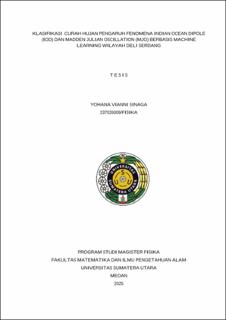Klasifikasi Curah Hujan Pengaruh Fenomena Indian Ocean Dipole (IOD) dan Madden Julian Oscillation (MJO) Berbasis Machine Learning Wilayah Deli Serdang
Classification Of Rainall Influence Of Indian Ocean Dipole (IOD) and Madden Julian Oscillation (MJO) Phenomena Based On Machine Learning In Deli Serdang Region

Date
2025Author
Sinaga, Yohana Vianni
Advisor(s)
Humaidi, Syahrul
Sinambela, Marzuki
Metadata
Show full item recordAbstract
Rainfall in the Deli Serdang region is influenced by global climate phenomena. This study aims to determine the classification of rainfall based on machine learning with the SVM model due to the simultaneous occurrence of IOD and MJO in the Deli Serdang region. Based on the analysis of rainfall values based on machine learning, the highest rainfall value was in October at the Sibiru-biru station 419 mm, while the lowest value was in February at the Batang Kuis station 71 mm. Conversely, the overall accuracy of the machine learning data, the higher the percentage, the better the model predicts rainfall. At a small RMSE, the better the model predicts the actual value. Strong MJO and negative IOD rainfall in Indonesia increases because more water vapor is available. Strong MJO and positive IOD have varying impacts, but generally can still increase rainfall in some areas. Weak MJO and positive IOD rainfall in Indonesia decreases, increasing the risk of drought. Increasing the accuracy of weather predictions by understanding the interaction patterns of MJO and IOD, machine learning-based weather prediction models can improve the accuracy of rainfall forecasts. Data from weather satellites, numerical models can be combined to provide more accurate information for the government and the public. This means that the values produced by machine learning analysis with the SVM model are very related to the IOD, MJO, and rainfall data
Collections
- Master Theses [310]
